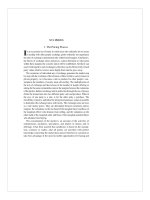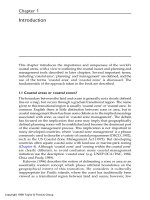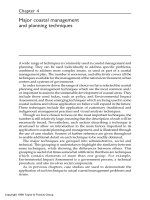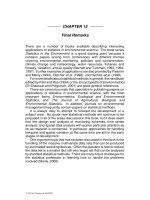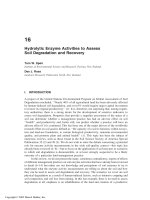NATURAL ARSENIC IN GROUNDWATER: OCCURRENCE, REMEDIATION AND MANAGEMENT - CHAPTER 16 pptx
Bạn đang xem bản rút gọn của tài liệu. Xem và tải ngay bản đầy đủ của tài liệu tại đây (4.25 MB, 12 trang )
Section 3: Arsenic biogeochemistry in
groundwater
Copyright © 2005 Taylor & Francis Group plc, London, UK
133
Natural Arsenic in Groundwater: Occurrence, Remediation and Management –
Bundschuh, Bhattacharya and Chandrasekharam (eds)
© 2005, Taylor & Francis Group, London, ISBN 04 1536 700 X
Natural enrichment of arsenic in groundwaters of Brahmanbaria
district, Bangladesh: geochemistry, speciation modeling and
multivariate statistics
Ondra Sracek
Institute of Geological Sciences, Faculty of Science, Masaryk University, Brno,
Czech Republic
Prosun Bhattacharya, Mattias von Brömssen, Gunnar Jacks
Groundwater Arsenic Research Group, Department of Land and Water Resources Engineering,
Royal Institute of Technology (KTH), Stockholm, Sweden
Kazi Matin Ahmed
Department of Geology, University of Dhaka,
Dhaka,
Bangladesh
ABSTRACT: Groundwater with geogenic arsenic enrichment is commonly encountered in the
Holocene sedimentary aquifers of the Bengal Delta Plain (BDP). The present study was carried
out in Brahmanbaria district, covering an area of 18 km
2
in northeastern Bangladesh. The Chandina
Formation is the main hydrostratigraphic unit of the area, which comprises silt and clay with high
content of organic matter. Dissolved arsenic concentrations in groundwater are high, reaching
Ͼ400 g/L in some wells. Groundwater is reducing with general lack of detectable dissolved oxy-
gen (DO) and contains low concentrations of nitrate and sulfate. Concentrations of dissolved Fe
are high, which is in general in agreement with the reductive dissolution of ferric oxide and
hydroxide hypothesis. Results of speciation modeling indicated the possibility of precipitation of
siderite, and to less extent, vivianite for many samples. The log P
CO2
values were extremely high
(ϾϪ1.0 atm), suggesting production of CO
2
in redox reactions involving the organic matter in the
sediments. Redox potential values calculated on the basis of different redox couples and field Eh
measurement indicated redox disequilibrium. Hierarchical cluster analysis (HCA) performed in
paired groups mode using the program PAST indicated highest degree of similarity among redox-
sensitive elements NO
3
, Mn, Fe, PO
4
, SO
4
, As, and pH. Na and Cl form a distinct group, which
indicate the influence of sea water. Bicarbonate generated in several redox reactions and carbonate
dissolution was linked to almost all parameters and this holds even more for the electrical conductiv-
ity (EC). Principal components analysis (PCA) yielded Principal Component 1 (PC1) correspon-
ding to sea water, and Principal Component 2 (PC2) corresponding to redox reactions with generally
high arsenic concentrations. In summary, combination of speciation modeling and multivariate
statistics proved to be useful in testing of conceptual model of geochemical evolution of arsenic-
rich groundwater.
1 INTRODUCTION
Natural arsenic in concentrations above the safe drinking water limits of World Health Organization
(10 g/L; WHO 2001), and above the national drinking water standard (50 g/L) is present in
groundwater of the Bengal Delta Plain (BDP) in many districts of Bangladesh (Mukherjee &
Bhattacharya 2001, Smedley & Kinniburgh 2002, Ahmed et al. 2004). The source of arsenic is
geogenic and is related to the sediments deposited by the rivers Ganges (Padma), Brahmaputra
Copyright © 2005 Taylor & Francis Group plc, London, UK
(referred as Jamuna in Bangladesh) and Meghna (Nickson et al. 2000, Bhattacharya et al.
2002a,b). Arsenic contaminated groundwater is common in the aquifers of alluvial lowlands,
comprising the floodplains of Padma and Brahmaputra (Jamuna) rivers, and also the Ganges
Delta. In this paper, we present applications of geochemical modeling and multivariate statistics
in development and support of conceptual model of arsenic behavior.
2 GEOLOGICAL SETTING
The BDP is a large sedimentary basin drained by the Ganges, Brahmaputra (Jamuna) and Meghna
(GBM) rivers (Fig. 1). Huge amounts of sediments have been transported and converged at the
lower reaches, forming the pro-grading delta at the head of the Bay of Bengal. In general, two
broad physiographic units characterize the BDP – elevated Pleistocene Terraces such as the Barind
and Madhupur tracts, floored with thick surficial oxidized clay and silty clay deposits, and the
Holocene lowlands.
The Holocene lowlands include piedmont plains, flood plains, delta plains and coastal plains
(Umitsu 1987 and 1993, Brammer 1996, Ahmed et al. 2004). The area of present investigation is
located in the Meghna Deltaic Plain comprising coarse-grained channel-fill deposits and fine
grained overbank deposits. During the late Holocene period, in several parts of the BDP, sediments
were deposited in marshy environments, as evidenced by occurrence of continuous layers of peat
(Umitsu 1993, Ravenscroft et al. 2001, Ahmed et al. 2004).
The present study was carried out in an area of 18 km
2
covering the Ashuganj and Brahmanbaria
Sadar Upazilas (sub-districts) in Brahmanbaria district in eastern Bangladesh (Fig. 2). The
Chandina Deltaic Plain (CDP), the major physiographic units covering the study area (Bakr 1977),
is generally flat and occurring at relatively higher levels than the surrounding floodplains. The
134
Figure 1. Map of Bangladesh showing the network of the rivers Ganges (Padma), Jamuna (Brahmaputra)
and Meghna rivers and the location of Brahmanbaria area. The major geomorphic domains, Barind and
Madhupur tracts of Pleistocene age (lighter tone) are seen distinctly within the vast tract of Holocene alluv-
ium. (Resolution: 625 meters; MODIS Data Type: MODIS-PFM; MODIS Band Combination: 1, 4, 3)
(Source map: />Copyright © 2005 Taylor & Francis Group plc, London, UK
sediments of the CDP are composed of silt, silty loam, silty clay belonging to the Chandina
Formation. The Chandina Formation is overlain by the Meghna alluvium and underlain by the
Pleistocene Madhupur Clay and Pliocene Dupi Tila Formation.
Neotectonic uplifts and course shifting of the Meghna and Old Brahmaputra rivers have
influenced sedimentation in this area, particularly during the late Holocene time. The source ter-
rains of most of these sediments were located in the areas around the Shillong Plateau in the north and
Tripura Hills on the east. A thick sequence of fine to very fine Holocene sediments overlies the
Pleistocene Madhupur Clay and Pliocene Dupi Tila sediments. The Holocene sediments are gen-
erally gray in color and contain high amount of organic matter while underlying older sediments
are characterized by reddish-brown, light brown and yellowish brown color and contain only low
amounts of organic matter (Table 1).
Groundwater from the Holocene sandy sedimentary aquifer is extracted by shallow hand tube
wells. Water levels in the Holocene aquifers fluctuate with annual recharge/discharge conditions,
with a maximum depth of 5–7 m bgs in pre-monsoon months. During the monsoon most of the
area if flooded and the groundwater level reaches the ground surface. The multiple aquifer system
135
Figure 2. Geological map of a part of the Chandina Delta Plain (CDP) in the Brahmanbaria district,
Bangladesh showing the location of the groundwater sampling.
Table 1. Hydrostratigraphy of the study area.
Age Unit Predominant Lithology Hydrogeological characteristics
Recent/Holocene Meghna Alluvium Grey clay, silt and fine sand Upper unconfined aquifer,
arsenic rich
Late Pleistocene Chandina Formation Grey silt, silty loam, silty clay Aquitard
Early Pleistocene Madhupur Clay Reddish brown clay Aquitard
Pliocene Dupi Tila Sands Yellowish brown medium to Lower aquifer, low in arsenic
fine sand
Copyright © 2005 Taylor & Francis Group plc, London, UK
in this area is characterized by variable hydraulic conductivity and water quality. Water quality is
often good except for occurrences of pockets of brackish water, remnants of paleo-seawater.
Occurrences of biogenic methane gas have also been reported from a number of places with the
BDP and particularly in the vicinity of the study area (Ahmed et al. 1998, Ravenscroft et al. 2001).
Arsenic and iron concentrations are frequently high in the Holocene aquifers. However, their conc-
entrations are significantly lower in the underlying Dupi Tila aquifers (BGS & DPHE 2001, van
Geen et al. 2003). This deeper aquifer probably receives recharge at their outcrops in the Tippera
Hills region, outside the political boundary of Bangladesh.
3MATERIALS AND METHODS
Samples of groundwater were collected during late November, 2000 from 30 domestic and
governmental tube wells placed at varying depths of 18–150 m (Fig. 2). Parameters like pH, redox
potential (Eh), temperature, and electrical conductivity (EC) were taken in the field. The pH was
measured using a Radiometer Copenhagen PHM 80 instrument using a combination electrode
(pH C2401-7). The Eh was measured in a flow-through cell using a combined platinum electrode
(MC408Pt) equipped with a calomel reference cell. Samples collected for analyses included:
(a) filtered (using Sartorius 0.45 m online filters) for major anions; (b) filtered and acidified with
suprapure HNO
3
(14 M) for the cations and other trace elements including arsenic (Bhattacharya
et al. 2002b). Arsenic speciation was performed with Disposable Cartridges(r) (MetalSoft Center,
PA) in the field, Meng et al. (2001). The cartridges adsorb As(V), but allows As(III) to pass
through. Sulfide was precipitated in the field by addition of Zn acetate. Major anions, Cl
Ϫ
, and
SO
4
2Ϫ
were analyzed in filtered water samples, with a Dionex DX-120 ion chromatograph with an
IonPac As14 column. NO
3
Ϫ
-N and PO
4
3Ϫ
-P was analyzed spectrophotometrically with a Tecator
Aquatec 5400. Ammonium (NH
4
ϩ
) was analyzed spectrophotometrically with a Tecator Aquatec
5400 at 540 nm wavelength. The major cations (Ca, Mg, Na and K) and minor and trace elements
(Fe, Mn, As) were analyzed by inductively coupled plasma (ICP) emission spectrometry (Varian
Vista-PRO Simultaneous ICP-OES) at Stockholm University. Dissolved organic carbon (DOC) in
the water samples were determined on a Shimadzu 5000 TOC analyzer (0.5mg/L detection limit
with a precision of Ϯ10% at the detection limit. Speciation modeling was performed by program
PHREEQC (Parkhurst 1995). Thermodynamic data for arsenic were taken from data base of pro-
gram MINTEQA2 (Allison et al. 1991). Multivariate statistics analysis was performed to verify
the hydrogeochemical similarities among geochemical parameters. The data were analyzed using
multivariate statistics implemented in the program PAST (Hammer et al. 2001).
4 GENERAL HYDROGEOCHEMISTRY
Selected results of the groundwater chemical analyses are presented in Table 2. In addition,
Bhattacharya et al. 2004 (in press) provide more detailed discussion on the trends of spatial
variability of water chemistry. Shallow groundwater (Ͻ50 m) in Brahmanbaria region was of
Ca-Mg-HCO
3
and Ca-Na-HCO
3
types (Fig. 3a). Groundwater samples had very variable HCO
3
Ϫ
(74–562 mg/L) and SO
4
2Ϫ
(bdl-32.9 mg/L) concentrations. In the intermediate and deeper aquifers
groundwater of Na-Cl-HCO
3
type was also found (Fig. 3b). Groundwater pH values were between
6.2 and 7.6. Field Eh values corrected with respect to hydrogen electrode were from ϩ0.180
to ϩ0.29 V, indicating moderately reducing conditions. However, these results do not represent
redox status of groundwater, possibly because of aeration of groundwater in hand-pump wells and
during pumping as discussed later.
Concentrations of total arsenic (As
tot
) in shallow wells varied from 10 to 335 g/L and in interm-
ediate wells reached up to 439 g/L. Concentrations of dissolved Fe were highly variable, from
0.28 mg/L to 10.3 mg/L. However, no correlation between dissolved iron (Fe
tot
) and As
tot
in shal-
low samples and only low correlation in intermediate depth samples were observed (Bhattacharya
et al. 2004, in press). Most of dissolved arsenic (up to 99.5%) was present as As(III). Concentrations
136
Copyright © 2005 Taylor & Francis Group plc, London, UK
137
Copyright © 2005 Taylor & Francis Group plc, London, UK
of NH
4
ϩ
were high in some shallow wells, reaching 12.2 mg/L. High concentrations of dissolved
organic matter (DOC, up to 21.8mg/L) were consistent with reducing character of groundwater.
Dissolved sulfide with concentrations up to 2.1 mg/L was found in several wells, indicating the
presence of sulfate reduction. Spatial variability of the distribution of arsenic in the shallow ground-
waters and its relationship with other chemical parameters is discussed in detail in Bhattacharya et al.
(2004, in press). Three domains were defined: Domain 1 with high concentrations As
tot
, and
PO
4
3Ϫ
and low Fe
tot
, and anomalous SO
4
2Ϫ
concentrations; Domain 2 with high concentrations of
As
tot
, and PO
4
3Ϫ
, and low concentrations of Fe
tot
, and sulfate; Domain 3 with low concentrations
of As
tot
, and PO
4
, and with high Fe
tot
, and sulfate concentrations (Fig. 4).
5 GEOCHEMICAL MODELLING
Results of calculations of saturation indices (SI) together with calculated log P
CO2
values are pres-
ented in Table 3. There was no significant complexation of Fe with other inorganic anions and the
138
Figure 3. Major ion characteristics of Brahmanbaria groundwaters plotted on a piper diagram . (a) Shallow
wells (Ͻ50 ) (b) Intermediate wells (50–150 m, black circles) and deep wells (Ͼ150 m, data not included in
discussion).
Figure 4. Spatial variability of total As (As
tot
) in the shallow wells of Brahmanbaria in eastern Bangladesh.
Copyright © 2005 Taylor & Francis Group plc, London, UK
principal aqueous species of Fe was Fe
2ϩ
and minor species was FeHCO
3
ϩ
. Concentrations of
Fe(III) were low, and the principal species were Fe(OH)
3
0
and, at lower pH, Fe(OH)
2
ϩ
. Low Mn conc-
entrations in groundwater within the reduced domains could possibly be due to precipitation of
rhodochrosite (MnCO
3
) (Sracek et al. 2000, McArthur et al. 2001, Ahmed et al. 2004). Calculated
log P
CO2
values were very high, reaching in some cases values higher than – 1.0. This is related to
the generation of CO
2
in redox reactions like dissolution of ferric oxide and hydroxides in reaction
with organic matter. This is consistent with high calculated values of DIC (up to 1.27 ϫ 10
Ϫ2
mol/L).
Many samples (60%) were at equilibrium or supersaturated with respect to siderite (FeCO
3
) sugg-
esting that this mineral phase might have acted as a sink for dissolved iron. Some samples (30%)
were also supersaturated with respect to vivianite Fe
3
(PO
4
)
2
.8H
2
O, but the degree of saturation is
generally lower than in the case of siderite. Few samples (13.3%) are also supersaturated with
respect to rhodochrosite. Some samples are close to equilibrium with calcite and dolomite (not
shown), but saturation is reached only in very limited number of samples.
The speciation program was also used to calculate Eh values based on As(III)/As(V) couple and
S(VI)/S(-II) couple determined analytically. Results of these calculations are presented in Table 4.
Typical feature is the strong disequilibrium between measured field Eh values adjusted with
respect to hydrogen electrode and values of Eh calculated on the basis of arsenic couple. Values of
redox potential based on arsenate to arsenite ratios are lower than the field Eh values. This holds
even more for sulfur redox couple, suggesting strong redox disequilibrium. However, the field Eh
values truncated at ϩ0.180V are possibly unreliable and must be interpreted with caution. There
139
Table 3. Results of speciation calculations.
Sample ID Depth (m) SI
siderite
SI
vivianite
SI
rhodochrosite
logP
CO2
(atm) DIC (mol/L)
1 18.3 Ϫ0.66 Ϫ3.80 Ϫ0.50 Ϫ1.94 2.73 ϫ 10
Ϫ3
2 21.3 0.81 2.57 0.57 Ϫ2.37 2.37 ϫ 10
Ϫ3
3 21.3 Ϫ0.52 Ϫ2.31 Ϫ0.12 Ϫ2.41 2.09 ϫ 10
Ϫ3
4 21.3 0.33 0.46 Ϫ1.11 Ϫ1.10 1.10 ϫ 10
Ϫ2
5 21.3 Ϫ0.02 Ϫ0.72 Ϫ1.48 Ϫ0.90 1.09 ϫ 10
Ϫ2
6 22.9 Ϫ1.13 Ϫ4.29 Ϫ1.79 Ϫ1.63 2.31 ϫ 10
Ϫ3
7 24.4 0.47 Ϫ0.14 Ϫ0.70 Ϫ1.20 8.73 ϫ 10
Ϫ3
8 24.4 0.15 Ϫ1.23 Ϫ1.51 Ϫ1.19 4.82 ϫ 10
Ϫ3
9 25.9 Ϫ0.57 Ϫ2.72 Ϫ1.78 Ϫ0.93 1.01 ϫ 10
Ϫ2
10 27.4 0.92 2.36 0.17 Ϫ2.09 3.62 ϫ 10
Ϫ3
11 27.4 0.05 Ϫ1.65 Ϫ1.14 Ϫ1.67 1.01 ϫ 10
Ϫ2
12 27.4 0.72 Ϫ0.70 Ϫ0.73 Ϫ1.47 3.96 ϫ 10
Ϫ3
13 27.4 0.11 Ϫ0.38 Ϫ1.42 Ϫ1.30 6.90 ϫ 10
Ϫ3
14 28.0 Ϫ0.22 Ϫ1.56 Ϫ1.68 Ϫ0.82 1.14 ϫ 10
Ϫ2
15 29.0 0.59 2.45 0.51 Ϫ2.78 1.16 ϫ 10
Ϫ3
16 29.0 0.16 Ϫ1.11 Ϫ1.15 Ϫ1.00 1.01 ϫ 10
Ϫ2
17 32.0 Ϫ0.07 0.01 Ϫ0.47 Ϫ1.96 2.04 ϫ 10
Ϫ3
18 32.0 0.39 Ϫ0.43 Ϫ0.99 Ϫ1.48 8.23 ϫ 10
Ϫ3
19 32.0 0.34 0.40 Ϫ0.69 Ϫ1.37 8.66 ϫ 10
Ϫ3
20 32.0 0.05 Ϫ1.06 Ϫ1.44 Ϫ0.78 1.24 ϫ 10
Ϫ2
21 39.6 0.68 2.04 Ϫ0.52 Ϫ1.68 9.74 ϫ 10
Ϫ3
22 41.1 Ϫ0.46 Ϫ1.92 Ϫ1.56 Ϫ1.13 1.03 ϫ 10
Ϫ2
23 54.9 0.94 1.80 Ϫ0.68 Ϫ1.48 8.26 ϫ 10
Ϫ3
24 59.4 0.08 Ϫ0.03 Ϫ1.51 Ϫ1.31 1.24 ϫ 10
Ϫ2
25 62.5 Ϫ0.55 Ϫ1.91 Ϫ1.41 Ϫ1.42 1.13 ϫ 10
Ϫ2
26 64.0 0.82 2.66 0.48 Ϫ2.18 2.45 ϫ 10
Ϫ3
27 64.0 0.12 Ϫ0.61 Ϫ1.62 Ϫ0.98 1.27 ϫ 10
Ϫ2
28 68.6 Ϫ0.73 Ϫ4.52 Ϫ1.10 Ϫ1.17 8.01 ϫ 10
Ϫ3
29 73.2 Ϫ0.10 Ϫ1.86 Ϫ2.12 Ϫ1.05 1.27 ϫ 10
Ϫ2
30 75.6 Ϫ0.15 Ϫ0.73 Ϫ1.49 Ϫ1.28 8.61 ϫ 10
Ϫ3
Copyright © 2005 Taylor & Francis Group plc, London, UK
also is a possibility of precipitation of secondary sulfide minerals like mackinawite. This mineral
is a precursor of pyrite and may incorporate some arsenic, acting as a sink for arsenic in ground-
water where sulfate reduction takes place.
6 MULTIVARIATE STATISTICS
Results of Hierarchical Cluster Analysis (HCA) performed in Ward’s mode using the program
PAST are given in Figure 5. They indicate highest degree of similarity among NO
3
Ϫ
, Mn, Fe
tot
,
PO
4
3Ϫ
, SO
4
2Ϫ
, As
tot
, and pH. Most of them are redox sensitive species, except for PO
4
3Ϫ
which is
linked to Fe due to its release during reductive dissolution of ferric oxide and hydroxides. The
effect of pH is however not clear, although this parameter plays a role in precipitation of minerals
like siderite and vivianite. Na
ϩ
and Cl
Ϫ
form a distinct group, which most likely indicates relict
sea water entrapped in the aquifers. Ca
2ϩ
and Mg
2ϩ
are separated from Na
ϩ
and Cl
Ϫ
because they
are related not only to relict sea water in the sediments, but also to processes like dissolution of
carbonates, and weathering of silicates enhanced by production of CO
2
in redox reactions. HCO
3
Ϫ
140
Table 4. Comparison of redox data.
Sample ID/ Eh (V) Eh (V)
Parameter Field Eh (V) As(V)/As(III) S(VI)/S(-II) SI
mackinawite
3 ϩ0.180 0.029 Ϫ0.252 3.09
16 ϩ0.180 0.059 Ϫ0.205 1.66
19 ϩ0.180 Ϫ0.011 Ϫ0.225 1.96
21 ϩ0.180 Ϫ0.073 Ϫ0.247 2.14
24 ϩ0.180 Ϫ0.018 ϽϪ0.254 1.55
Similarity
HCO
3
-
CI
-
Na
+
NO
-
3
Mn
Fe
tot
PO
4
3-
K
+
pH
SO
4
2-
Mg
2+
Ca
2+
EC
As
tot
0
-100
-200
-300
-400
-500
-600
-700
-800
12345678 91011121314
Figure 5. Results of Hierarchical Cluster Analysis (HCA).
Copyright © 2005 Taylor & Francis Group plc, London, UK
generated in several redox reactions and carbonate dissolution is linked to almost all parameters and
this holds even more for EC.
Results of Principal Components Analysis (PCA) presented in Figure 6 indicate two principal
components and identified as: PC1 with high loadings for EC, Na
ϩ
, Cl
Ϫ
, and HCO
3
Ϫ
, and PC2
with high loading for HCO
3
Ϫ
and with relatively low, but significant loading for arsenic. The PC1
corresponds to the influence of relict seawater entrapped in the sediments to the groundwater, and
PC2, which corresponds to the impact of redox reactions. These principal components explain
92.01% and 6.71%, respectively, of total variance in sample set. The samples at the bottom right
(27 and 28, Fig. 6) indicate strong influence of saline water, most likely reflect to be relict seawa-
ter entrapped in the sediments. On the other hand, samples at the top of the graph (4, 11, 21, 22,
25 etc., Fig. 6) are strongly influenced by redox reactions and they generally have high arsenic
concentrations. Samples at the bottom left (1, 2, 3, 6, 17 etc., Fig. 6) are relatively less influenced
by both processes and have low arsenic concentrations. It seems that redox processes relatively
less influence the samples showing signature of relict saline water from the marine sources. However,
the impact of palaeo-seawater relicts in the aquifers seems to be a local phenomenon in the
Brahmanbaria area, which is also seen in many other areas of Bangladesh.
7 DISCUSSION AND CONCLUSIONS
The conceptual model of arsenic and iron behavior in groundwater in Bangladesh can be summar-
ized as follows:
(a) reductive dissolution of ferric oxide and hydroxides in reaction with organic matter like peat
after consumption of more favored electron acceptors in a reaction like:
141
1
2
3
4
5
6
7
8
9
10
11
12
13
14
15
16
17
18
19
20
21
22
23
24
25
26
27
28
29
30
400
300
200
100
1000
Component 1
Component 2
2000 3000
0
-100
-200
Figure 6. Results of Principal Components Analysis (PCA).
Copyright © 2005 Taylor & Francis Group plc, London, UK
where CH
2
O represents simplified organic matter. This reaction produces dissolved Fe(II),
increases DIC concentration, and raises pH. Also, arsenic initially present on adsorption sites is
released to groundwater.
(b) Precipitation of Fe(II) as siderite, FeCO
3
, and vivianite, Fe
3
(PO
4
)
2
.8H
2
O. These processes d-
ecrease dissolved Fe(II) and, in the case of siderite precipitation, there is reduction of DIC conc-
entration. However, the impact on DIC and bicarbonate concentrations is limited because their
pools are much larger than dissolved iron pool. When sulfate reduction takes place, minerals like
mackinawite also act as active sinks for dissolved iron. However, sulfate concentrations are gene-
rally low and this process does not seem to be very significant.
This means that correlation between dissolved iron and arsenic frequently observed at sites con-
taminated by arsenic may be disturbed because behavior of dissolved arsenic is more conservative
than behavior of dissolved iron. There are no important minerals of arsenic in groundwater with
low sulfate concentrations and adsorption of arsenic is limited in alkaline pH region (Langmuir
1997). Results of speciation modeling are consistent with the conceptual model (Bhattacharya et al.
1997, Nickson et al. 2000, Bhattacharya et al. 2002a,b, Ahmed et al. 2004) because there are very
high P
CO2
and DIC values in samples with high arsenic concentrations. Also, many samples are
supersaturated with respect to siderite, and, to less extent with respect to vivianite. Presence of fer-
rous carbonate and phosphate minerals was also confirmed by sequential extraction (Ahmed et al.
2004).
Multivariate statistics groups together redox-sensitive parameters like Fe, Mn, As, and DOC.
Phosphate is also in the same group because it is indirectly linked to redox processes through its
release in reductive dissolution of ferric oxide and hydroxides. Potential initial source of phos-
phate is decomposition of peat as well as organic matter disseminated in the alluvial sediments
(Routh et al. 2000, Ravenscroft et al. 2001). In contrast, there is less resemblance with bicarbon-
ate, which can also be produced by other processes like dissolution of soil calcite. Multivariate stat-
istics also helped to identify samples with a significant impact of sea water. Samples with a
significant seawater impact had high loadings for typical sea water ions such as Na
ϩ
and Cl
Ϫ
.
Sulfate was less useful indicator because its concentration was very low.
The combination of geochemical modeling and multivariate statistics has been proved to be a
useful tool in testing the hypothesis about arsenic release mechanism.
ACKNOWLEDGEMENTS
The authors would like to acknowledge the Swedish Research Council (VR) and Sida-SAREC for
supporting the research on High arsenic groundwater in Bangladesh since January 1997. The
authors would like to thank Andreas Mende for his valuable suggestions to improve the manuscript.
REFERENCES
Ahmed, K.M., Hoque, M., Hasan, M.K., Ravenscroft, P. & Chowdhury, L.R. 1998. Origin and occurrence of
water well methane gas in Bangladesh aquifers. Jour. Geol. Soc. India 51: 697–708.
Ahmed, K.M., Bhattacharya, P., Hasan, M.A., Akhter, S.H., Alam, S.M.M., Bhuyian, M.A., Imam, M.B.,
Khan, A.A & Sracek, O. 2004. Arsenic enrichment in groundwater of the alluvial aquifers in Bangladesh:
An overview. In P Bhattacharya, AH Welch, KM Ahmed, G Jacks, R Naidu (eds.) Special Issue: Arsenic in
Groundwater of Sedimentary Aquifers, Appl. Geochem. 19(2): 181–200.
Allison, J.D., Brown, D.S. & Novo-Gradac, K.J. 1991. MINTEQA2, A Geochemical Assessment Data Base
and Test Cases for Environmental Systems, Athens, GA, U.S. EPA.
Bakr, M.A. 1977. Quaternary Geomorphic Evolution of the Brahmanbaria-Noakhali Area, Comillaand
Noakhali Distrcits, Bnagladesh. Records of the Geological Survey of Bnagladesh, Volume 1, part 2, 48p.
BGS & DPHE 2001. Arsenic Contamination of Groundwater in Bangladesh. Vol 2 Final Report, BGS
Technical Report WC/00/19.
142
Copyright © 2005 Taylor & Francis Group plc, London, UK
Bhattacharya, P., Chatterjee, D. & Jacks, G. 1997., Occurrence of arsenic contaminated groundwater in allu-
vial aquifers from Delta Plains, Eastern India: Options for safe drinking water supply. Int Jour. Water Res.
Management 13(1): 79–82.
Bhattacharya, P., Frisbie, S.H., Smith, E., Naidu, R., Jacks, G. & Sarkar B. 2002a. Arsenic in the Environment:
A Global Perspective. In B.Sarkar (ed.) Handbook of Heavy Metals in the Environment (Chapter 6), New York:
Marcell Dekker Inc., pp. 145–215.
Bhattacharya, P., Jacks, G., Ahmed, K.M., Khan, A.A. & Routh, J. 2002b. Arsenic in groundwater of the
Bengal Delta Plain aquifers in Bangladesh. Bull. Env. Cont. Toxicology 69: 538–545.
Bhattacharya, P., Ahmed, K.M., Broms, S., Fogelström, J., Jacks, G., Sracek, O. & Routh, J. 2004. Mobility of
arsenic in groundwater in a part of Brahmanbaria district, NE Bangladesh In: Naidu, R., Smith, E., Smith, L.,
Smith, J. and Bhattacharya, P. (Eds.) Managing Arsenic in the Environment: From soil to human health.
CSIRO Publishing, Melbourne, Australia. (In press)
Brammer, H. 1996. The Geography of the Soils of Bangladesh. University Press Ltd., Dhaka, Bangladesh.
Hammer, Ø., Harper, D.A.T. & Ryan, P.D. 2001. Past: Paleontological Statistics Software Package for
Educational and Data Analysis. Paleontologica Electronica 4(1): 9 p.
Langmuir, D. 1997. Aqueous Environmental Geochemistry, Prentice Hall, New Jersey.
McArthur, J.M., Ravencroft, P., Safiullah, S. & Thirlwall, M.F. 2001. Arsenic in groundwater: testing pollu-
tion mechanism for sedimentary aquifers in Bangladesh. Water Resour. Res. 37: 109–117.
Meng, X., Korfiatis, G.P., Christodoulatos, C. & Bang, S. 2001. Treatment of arsenic in Bangladesh well
water using a household co-precipitation and filtration system. Wat. Res. 35: 2805–2810.
Mukherjee, A.B. & Bhattacharya, P. 2001. Arsenic in groundwater in the Bengal Delta Plain: Slow Poisoning
in Bangladesh. Environmental Reviews 9(3): 189–220.
Nickson, RT, McArthur, J.M., Ravenscroft, P., Burgess, W.G. & Ahmed, K.M. 2000. Mechanism of arsenic
release to groundwater, Bangladesh and West Bengal. Appl. Geochem. 15(4): 403–413.
Parkhurst, D.L. 1995. Users Guide to PHREEQC-A Computer Program for Speciation, Reaction-Path,
Advective-Transport, and Inverse Geochemical Calculations, U.S. Geological Survey Water Resources
Investigation Report 95–4227.
Ravenscroft, P., McArthur, J.M. & Hoque, B.A. 2001. Geochemical and paleohydrological controls on pollu-
tion of groundwater by arsenic. In Chappell, W.R., Abernathy, C.O. & Calderon R.L. (eds.) Fourth International
Conference on Arsenic Exposure and Health Effects.
Routh, J., Bhattacharya, P., Jacks, G., Ahmed, K.M., Khan, A.A. & Rahman, M.M. 2000. Arsenic geochem-
istry of Tala groundwater and sediments from Satkhira District, Bangladesh. Eos Trans American Geophysical
Union 81(48): 550
Smedley, P. & Kinniburgh, D.G. 2002. A review of the source, behavior and distribution of arsenic in natural
waters. Appl. Geochem. 17: 517–568.
Sracek, A., Bhattacharya, P., Jacks, G., Chaterjee, D., Larsson, M. & Liess, A. 2000. Groundwater arsenic in
the Bengal delta Plains: A sedimentary geochemical overview. In: A.L. Ramanathan, V. Subramanian &
R. Ramesh (eds.) Proc. International Seminar on Applied Hydrogeochemistry’ Annamalan University,
Tamil Nadu, India, pp. 47–56.
Umitsu, M. 1987. Late Quaternary sedimentary environment and landform evolution in the Bengal Lowland.
Geog. Rev. Japan (Ser. B) 60: 164–178.
Umitsu, M. 1993. Late Quaternary sedimentary environments and landforms in the Ganges Delta. Sed. Geol.
83, 177–186
van Geen, A., Ahmed, K.M., Seddique, A.A. & Shamsudduha, M. 2003. Community wells to mitigate arsenic
crisis in Bangladesh. Bulletin of the World Health Organization 81(9): 632–638.
WHO 2001. Arsenic in drinking water. Fact sheet 210: URL:
(Accessed on March 9, 2004)
143
Copyright © 2005 Taylor & Francis Group plc, London, UK

